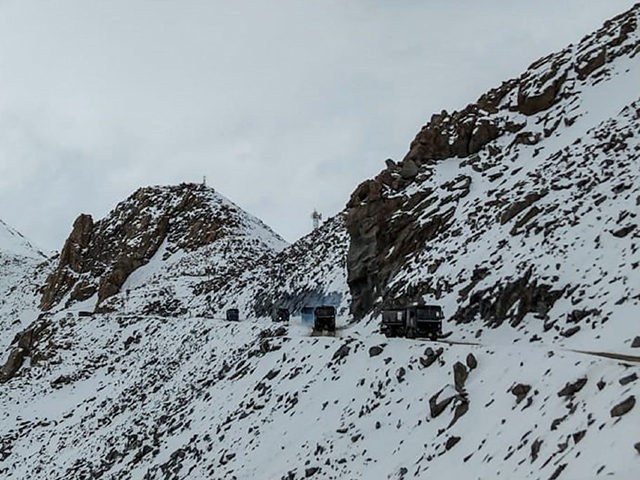India’s External Affairs Minister Subrahmanyam Jaishankar warned Tuesday that Chinese “close up deployments” on the two countries’ border still continue over a year after a Chinese invasion of Indian territory led to a military clash killing dozens.
China and India dispute where their border lies along the Himalayan mountains; China claims much of India as a non-existent Chinese territory branded “South Tibet.” In June 2020, Indian forces found an encampment of People’s Liberation Army (PLA) soldiers in the Galwan Valley, part of the Ladakh region, and confronted them, resulting in a brawl in which New Delhi claimed to have lost 20 soldiers and killed twice as many.
The Chinese Communist Party denied most of those deaths but spent months refusing to confirm any lives were lost at all. Beijing finally admitted to only four deaths in February and has since silenced skeptics in the country questioning the low death toll.
Jaishankar, speaking at the Qatar Economic Forum, suggested similar clashes could continue along the mutual border, known formally as the Line of Actual Control (LAC), if China refused to respect where it ended and where India began. He noted that the two countries had engaged in months of diplomacy resulting in “written commitments” to which Beijing needed to adhere.
Jaishankar broke down “two big issues” between the countries, according to Indian media.
“One, of course, is that the close-up deployments still continue, especially in Ladakh. The issue there is whether China will live up to the written commitments which are made about both countries not deploying a large armed force at the border,” the top diplomat noted. “And the larger issue really, whether we can build this relationship on the basis of mutual sensitivity, mutual respect and mutual interest.”
Jaishankar described the two as “independent from each other.” His remarks followed a warning last week from the nation’s defense minister, Rajnath Singh, to China not to trigger further Indian military actions to keep Beijing from seizing territory.
“We seek world peace (but) if someone shows us an aggressive attitude, we will respond,” Defense Minister Singh told reporters on June 17, insisting India “has the capability to reply to aggression” even from the world’s most populous army.
“[L]ast year in Galwan Valley, our soldiers displayed exemplary courage and valour in line of duty. I salute all brave soldiers who laid down their lives fighting for the nation [sic],” he added, reminding China of its defeat last year. Following that exchange, India rescinded a nearly half-century-old rule banning the use of firearms on the border with India, which was responsible for why no shots were fired in the Galwan Valley brawl. In September, the first shots across the border in 45 years were shot in an incident in which Indian forces dislodged another PLA unit attempting to establish itself on a mountaintop overlooking Pangong Tso, a lake in “South Tibet.”
The Chinese Foreign Ministry responded to a question about Jaishankar’s comments Wednesday by claiming that India, not China, was intimidating its neighbor with ongoing troop deployments on the border contrary to the spirit of diplomatic agreements between the two. Spokesman Zhao Lijian did not deny that China was amassing troops on the border, but called it a “normal defense arrangement.”
“For a long time, the Indian side has been increasing its military deployment along the China-India border and encroaching on China’s territory,” Zhao claimed. “This is the root cause of tension along the China-India border. China always stands for a peaceful settlement of the boundary issue through negotiation and against linking the boundary issue with bilateral relations.”
Jaishankar’s concerns of a growing, menacing Chinese presence in the Himalayas follows months of similar reports. In January, during some of the most difficult weather that presents itself in the region, New Delhi Television (NDTV) reported that satellite images from Arunachal Pradesh, a border region China claims as “South Tibet,” showed the construction of an entire Chinese village within Indian territory. The satellite photos allegedly showed as many as 101 new homes illegally built and inhabited by Chinese citizens in the region.
“The latest image that establishes the village in question is dated November 1, 2020. The image dated a little more than a year before that — August 26, 2019 — does not show any construction activity. So, the village was set up in the last year,” NDTV noted at the time.
As with the Indian government’s comments this week, Beijing did not deny that report, instead insisting that construction in “South Tibet” was legitimate and a “matter of sovereignty” no foreign countries should question.
Indian media again accused the PLA of provocative activities on the border in May, this time military exercises on the border. Again, the Chinese government did not deny the reports, insisting the activities were legitimate.
“[I]t is routine for the Indian and Chinese armies to make deployments along the border in summer, with experts warning India not to misjudge the situation and trigger a new round of conflict,” the Global Times, a Chinese state-run propaganda outlet, asserted in May.

COMMENTS
Please let us know if you're having issues with commenting.